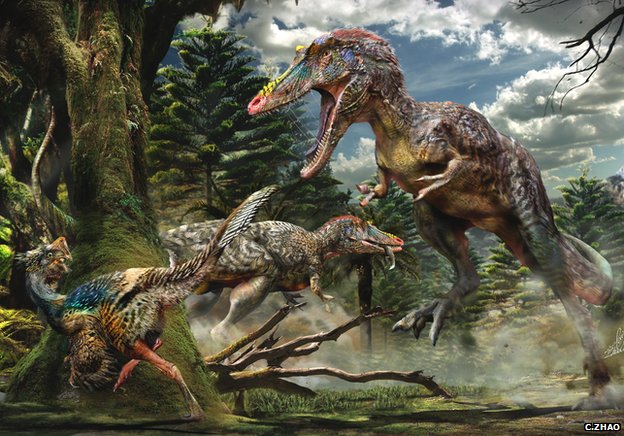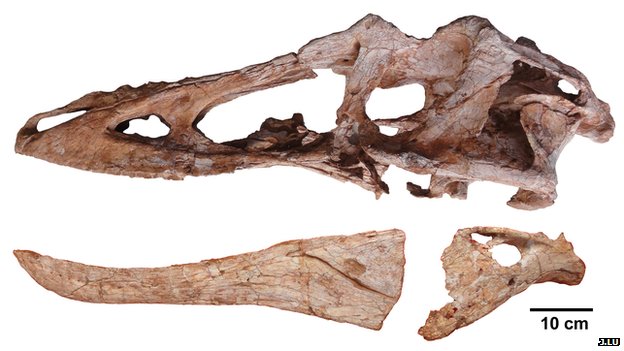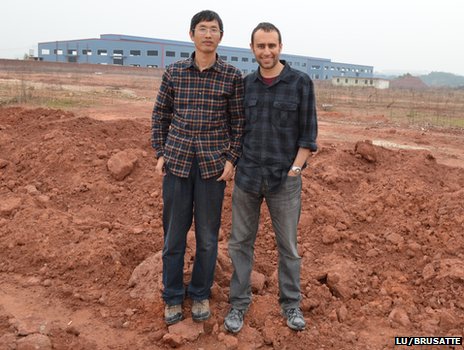fossilshk
(Lung)
管理員
  








UID 1
精華
23
積分 4775
帖子 2827
閱讀權限 200
註冊 2006-7-14
來自 中國/香港
狀態 離線
|
[廣告]:
New Tyrannosaur named 'Pinocchio rex'

Pinocchio was smaller than T. rex but its nose was a third longer - perhaps for a different hunting strategy
A new type of Tyrannosaur with a very long nose has been nicknamed "Pinocchio rex".
The ferocious carnivore, nine metres long with a distinctive horny snout, was a cousin of Tyrannosaurus rex.
Its skeleton was dug up in a Chinese construction site and identified by scientists at Edinburgh University, UK.
The 66-million-year-old predator, officially named Qianzhousaurus sinensis, is described in Nature Communications.
"Pinocchio" looked very different to other tyrannosaurs.
"It had the familiar toothy grin of T. rex, but its snout was long and slender, with a row of horns on top," said Edinburgh's Dr Steve Brusatte.
"It might have looked a little comical, but it would have been as deadly as any other tyrannosaur, and maybe even a little faster and stealthier.
"We thought it needed a nickname, and the long snout made us think of Pinocchio's long nose."
Researchers now think several different tyrannosaurs lived and hunted alongside each other in Asia during the late Cretaceous Period, the last days of the dinosaurs.

The enormous Tarbosaurus (up to 13m) had deep and powerful jaws like T. rex - strong enough to crush the bones of giant herbivores.
The thinner teeth and lighter skeleton of Qianzhousaurus suggest it hunted smaller creatures, such as lizards and feathered dinosaurs. But at nine metres tall and weighing almost a tonne, it was still a gigantic carnivore.
"You wouldn't want to run into either of these guys," said Dr Brusatte.
'Weird features'
Pinocchio's snout was 35% longer than other dinosaurs of its size. So, why the long face?
"The truth is we don't know yet. But it must've been doing something different," Dr Brusatte told BBC News.
"The iconic picture of a tyrannosaur is T. Rex, the biggest, baddest dinosaur of all.
"But this new species was lighter, less muscular. It breaks the mould. Perhaps it had a faster bite and hunted in a different way."

Prof Junchang Lu and Dr Steve Brusatte at the discovery site
The discovery of "Pinocchio" settles an argument over a series of strange new fossil finds.
In recent years, two tyrannosaurs with unusually prominent proboscises were dug up in Mongolia, and named Alioramus.
The horny-snouted predators appeared to come from an entirely new branch of the tyrannosaur family.
"The trouble was, they were both juveniles. So it was possible their long snouts were just a weird transient feature that grows out in adults," said Dr Brusatte, an expert in tyrannosaur evolution.
But this new Qianzhousaurus specimen is an almost fully mature adult. It was found largely intact and remarkably well preserved by road construction workers near Ganzhou in southern China.
"It's twice the size of the juveniles, and yet it still shows the same features - including the distinctive horns," said Dr Brusatte.
"This is the slam dunk we needed: the long-snouted tyrannosaurs were real."
Palaeontologists are now confident that Qianzhousaurus and Alioramus are part of a new subgroup of tyrannosaurs with elongated skulls.
Their discovery from Mongolia to southern China suggests these "second tier" carnivores were widely distributed, according to Prof Junchang Lu of the Chinese Academy of Geological Sciences, a co-author on the paper.
"Although we are only starting to learn about them, the long-snouted tyrannosaurs were apparently one of the main groups of predatory dinosaurs in Asia," he said.
With these "weird" creatures now accepted as being part of a whole family, more and more of their long-snouted relatives are expected to be unearthed.
As for the riddle of Pinocchio's nose, the scientists hope to solve it via biomechanical studies of its jaw - which may hint at its feeding habits.
http://www.bbc.com/news/science-environment-27296357 7 May 2014
| 
 |
|



